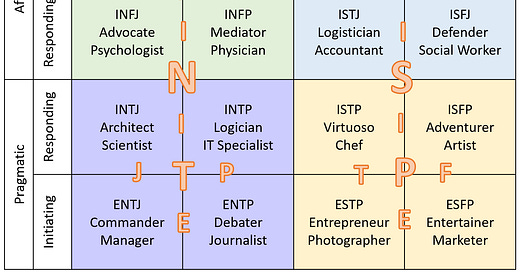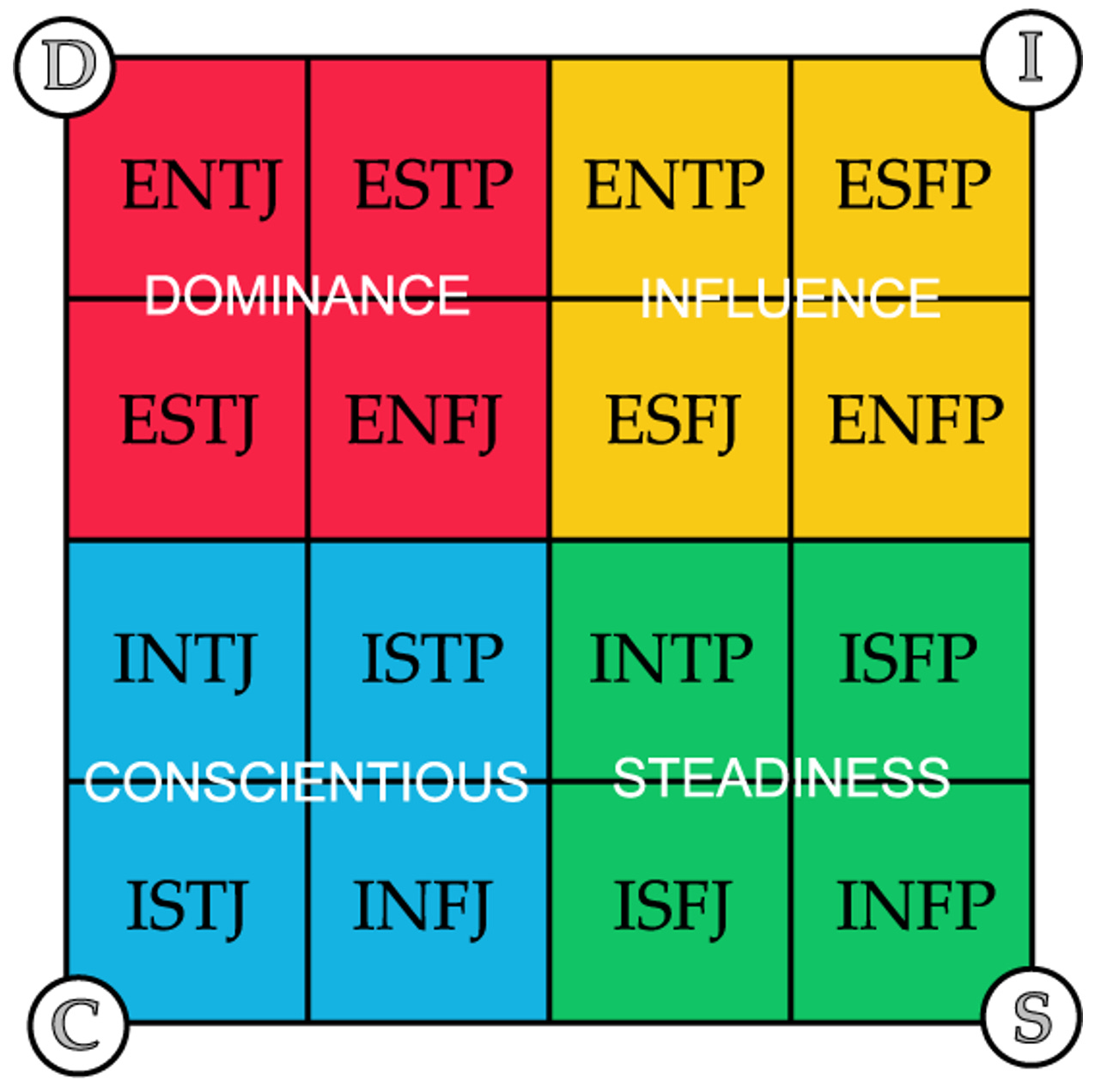Myers-Briggs Type Indicator (MBTI) and DISC behavioural styles are commonly used to classify people into personality profiles. Businesses are tempted to recruit and position job functions based on personality type. This approach is no different from using astrology or Zodiac. I think because of the simplicity of the stereotype, it makes DISC and MBTI popular.
Personality is like describing colour. If we define the world with 4 colours, it is like DISC model. 16-colour is like the MBTI model. Big-5 traits let go the grouping of colours, and instead use measurements like hue, saturation, lightness, opacity etc.
Personality is composed of thoughts, behaviours, and emotional responses. Psychologists prefer the Big 5 (OCEAN or CANOE) traits without using a fixed personality type.
Openness to Experience - level of curiosity and imagination
Conscientiousness - a good indicator of accountability and productivity
Extraversion - where we draw energy from
Agreeableness - compassion and trust in others
Neuroticism - how stable are our emotions
We shall note that:
Personality is not a fixed measurement on a scale, like you are 80% and I am 35% on the Introvert-to-Extroverted scale. In reality, one can have different extroverted behaviours based on circumstances. Hence, MBTI and DISC models lack flexibility and fluidity.
there is no superiority or inferiority in any one of the personality types
Do MBTI on a regular assessment and not a once-off TEST. If you repeat the evaluation a few months later or test on another set of questionnaires, you may get a different personality type.
Zodiac and personality types fall into the cognitive bias called the Barnum Effect (Forer Effect), a human tendency to believe vague descriptions are a fit.
Personality is a preference, not a competency ability. For example, we may have a dominant preference for using the right or left hand.
Due to the simplicity of MBTI personality model, it does offer certain use cases in the business workplace, however, we shall use it with care. Here are some recommendations for V-Work team members when beginning to explore MBTI assessment:
Dos:
combine or use Big-5 traits, which use specific traits and have been shown scientifically to be a better predictor of workplace performance.
Since MBTI and DISC are easier to understand, it is a beginner step to raise self-awareness, learn how to leverage our strengths and seek compliments from our colleagues’ strengths to support our weaknesses.
use MBTI broadly, but it lacks the accuracy of defining individual (specific) traits, such as understanding cognitive functions and raising awareness of personality traits.
Embrace diversity in the team. If we assemble most team members with liked-personality, there will be a lack of checks and balances and different opinions.
increased awareness and appreciation of the different personalities can improve communications with varying style
Don’ts
placing heavy decision weightage (judgment) for hiring and job positions based on personality type. Many studies show that MBTI tests are unstable and lack empirical evidence; hence, they may introduce unjustified biases toward decision-making about people’s placement based on personality types.
Use personality type to define who you are or label someone else. Avoid using personality type as a fixed identity, as an excuse for not making the right changes, or as an accusation that others are a specific personality type unfit for a job.
Understanding how a ‘labeling’ method like MBTI derived from Car Jung’s works is valuable and exciting.
Cognitive Functions
Psychologist Carl Jung’s model of the human psyche comprises the ego, the personal unconscious, and the collective unconscious.
The ego == identity, conscious mind
The Personal Unconscious == repressed memories
The Collective Unconscious == culturally inherited unconscious knowledge and experiences. There are a few Jungian Archetypes:
The Persona
The Anima
The Shadow
The Self
Carl Jung believed that humans experienced the world with 4 primary cognitive functions, and one of them is the dominant function in an individual:
Perception: Intuition vs. Sensation, how people perceive reality and gather information
Judging: Feeling vs. Thinking, how people make decisions
The functions can be grouped into dichotomy (opposing) functions depending on where we draw energy from, internally or externally. Now, it forms 8 groups:
Carl Jung suggested that they are dominant, less dominant, less preferred, or even suppressed cognitive functions. Hence, the Myers-Briggs mother-daughter team devised the MBTI model, which captures the variation and forms the 16 personalities.
(1) Dominant function
(2) Auxiliary (second dominant function)
(3) Tertiary function (not a preferred to-use function in normal circumstances)
(4) Inferior function (suppressed function)
The degree of conscious control decreases from (1) dominant to (4) inferior function. In the MBTI model, individuals may behave in the Loop or Grip under stress. A loop is stuck in dominant to tertiary functions (1) to (3), leading to unhealthy oscillation. For example, INTJs may be overanalyzed and stuck in the loop. The grip is when one ‘explodes’ or acts weird (‘out of normal character’) when one only uses the inferior function.
In the dichotomy settings, (1) + (4) are a pair; the most dominant suppresses another opposite function (in the quadrant). (2)+(3) are the second set of functions; they are in diagonal quadrants, too. If (1) is extrovert, then (2) is introvert, and vice versa, again in the opposing manner. These sets are Judging (J) or Perceiving (P), or vice versa.
Decoding MBTI Labels
MBTI is often labeled as 4 or 5 characters string:
1234 or another variant 1234-X
e.g. INTJ or INTJ-A
The fifth character X is A or T, a reflection of the individual’s response to stress
(A) Assertive - confident, more resistant to stress
(T) Turbulent - insecure, vulnerable to stress
In the main four characters, 1234
[1] is either Introverted (I) or Extroverted (E), this is the dominant function
The middle characters [2] and [3] are always one for Perception (either N for iNtuition, or S for sensing), and another character for Judging (T for Thinking, or F for feeling)
e.g. INTJ, the middle characters are NT, so Perception is iNtuition (N) and Judging is Thinking (T).
[4] the Extroverted function is revealed in the 4th character (this is an important step), either Judging (J) or Perceiving (P).
e.g. INTJ, J is extroverted, and INTJ, T is present in the middle 2 characters, no F. Hence Judging is Extroverted Thinking (Te). Because INTJ, the first character dominant, is Introverted (I), not extroverted, we know that Te has to be an auxiliary function.
Dominant:
Auxiliary: Te
Tertiary:
Inferior:
Once we know either one of the middle characters, like NT in INTJ, if judging is thinking (T), then N is perception = intuition. The auxiliary function has been identified as Te Judging; the remaining Perception has to be Introverted intuition (Ni).
Dominant: Ni
Auxiliary: Te
Tertiary:
Inferior:
From the dichotomy, we already learned that Inferior is the suppressed function from the most dominant function. The opposite of Ni in the quadrant is Se (Extroverted Sensing). So, INTJs are most fearful of using external-facing sensory input to perceive the world; it makes them the most uncomfortable.
Dominant: Ni
Auxiliary: Te
Tertiary:
Inferior: Se
The last piece of the cognitive function stack is Tertiary, the dichotomy of the auxiliary function. Opposite of Te is Fi in the judging quadrant.
Dominant: Ni
Auxiliary: Te
Tertiary: Fi
Inferior: Se
This is an example of how we define INTJ as Ni Te Fi Se sequence, the personality as the “Mastermind”. Now the descriptions we read about the 16 personalities are based on the stack. The key are dominant functions 1 to 3 (dominant → auxiliary → tertiary) and the suppressed (4) inferior function.
If we do another example for ESFP:
Looking for (4th character) P, perceiving is either sensing (S) or iNtuition (N), so we find Se, and the 1st character is Extroverted, so Se is Dominant. The interior is the opposite of the dominant function, and we identify the inferior function as Ni. ESFP, the leftover of the middle 2 characters is F, then the auxiliary is Fi (cannot be Fe because we already applied extroverted as dominant). Tertiary is the opposite of auxiliary, hence it is Te.
Dominant: Se
Auxiliary: Fi
Tertiary: Te
Inferior: Ni
I find that understanding the coding is helpful in understanding the limitations of MBTI and its possible applications.
[image source: understanding MBTI]
We can view the grouping of 1234-X by the middle 2 characters; it forms the following quadrants:
[image source: Quora]
In short, I think the cognitive functions are more valuable than the 16 personality types in raising our awareness about individuals' different preferences when perceiving reality and making decisions.









